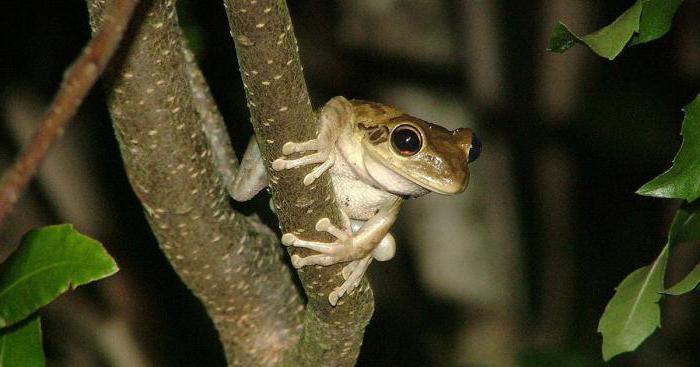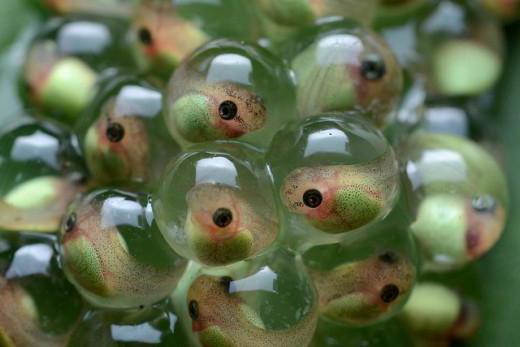The common tree frog, a representative of the order of the tailless family of tree frogs, is a miniature frog with a body length of about 5.5 cm, long hind legs and a glossy surface of the skin. The tree frog is remarkable for the variability of the color of the skin. This change can happen literally before our eyes: it all depends on the color of the surrounding substrate and the emotional state.
The usual color of the frog is green, but can acquire all shades of white, gray and brownish-brown colors. Common tree frog (amphibian class) is a peace-loving and neat creature. This article will tell about her, her habitat in nature and the features of home content.
Wildlife Lifestyle
A tree frog (the second name for tree frogs) is found in almost the entire European territory. Usually calm, she sits on stones, plants, trunks or leaves of trees in the grass. You can’t immediately notice it in nature - with its appearance, tree frog resembles a leaf of a tree; moreover, it is well disguised as the surrounding surroundings. So she hunts, waiting for insects. Tree frog is an active animal: it swims superbly and easily jumps onto plants. In nature, tree frog activity increases with the onset of twilight, it is at this time that the real hunt begins. The darkness does not prevent the frog from looking for prey - it has excellent eyesight. The vast majority of its diet is made up of flying insects: mosquitoes, flies, butterflies. But she does not disdain catching small, mobile animals. Her weapon is not only a sticky tongue, but also the jaw with which she can capture flightless prey. Is tree frog poisonous? No, this is a harmless species, tree frog honestly captures prey without paralyzing it. The frog is protected from external danger by its ability to hide, merging with the outside world.

In summer, in the active season, tree frogs do not hide in crevices or minks. They rest and hide from danger and bad weather in the foliage of shrubs or grass. They wait for the winter underground, climbing into holes left by other animals, under stones, in crevices of rocks, hollow trees, they can go to winter to the bottom of a reservoir.
Tree frog breeding
For breeding, frogs need to choose a suitable place - a standing reservoir, surrounded by shores with high vegetation (trees, shrubs, reeds). Males, sitting in water or on bushes, attract females with rhythmic calls, thanks to the available throat resonators. We all heard the croaking of frogs. It is the developed resonators that nature supplied the males that allow them to make very loud sounds. An impressive chorus spontaneously organized in the spawning pond, where all the males gather, reaches its climax, usually in the evening. Females come to the breeding site only to lay eggs and leave, and males do not leave here for the entire spawning period, so they are always the majority and females in the pond.

The female lays several servings (from 3 to 21) of eggs, which are a lump of various number of eggs attached to aquatic plants. They can be from 15 to 215 pcs. Embryos develop one to two weeks, transforming into larvae grow another 1.5-3 months. It happens that the larvae winter and grow in small frogs only in the next year. Little tree frogs are first kept on the banks of their native reservoir, and then, by analogy with the behavior of adults, they find a place for wintering. Tree frogs become sexually mature at the age of 2-4 years. In the wild, common tree frog can live up to 12 years, and when kept in a terrarium - up to 20-22.
Challenges: population decline
Common tree frog is a vivid example of the rapid disappearance of amphibians. Over the past 100 years, its range within Russian borders has declined markedly - in some central regions of the European part and within the Southern Urals, this species of frogs has disappeared. Tree frogs are also declining in other European countries. The main cause of this disaster is industrial pollution of the environment, or, as is commonly called, biotopes of the species.
Maybe that’s why tree frogs have become a favorite content in home terrariums today. Let's talk about the rules for caring for these animals and the necessary equipment to ensure their comfortable life.
What to prepare: vertical terrarium
For tree frog, a vertical-type aquaterrarium is suitable, including a small body of water, a stretch of coast, and vegetation. The minimum size of the terrarium for 1-2 animals is 20x20 cm at the base and 50 cm in height (excluding the height of the lamp). Equip the tank with additional downward daytime heating using an incandescent or mirror lamp. At night, the terrarium is not heated. Temperature during the day should be maintained at 23-26 ° C, at night - 16-20 ° C.
Inside, imitating the natural landscape:
• Place small snags, branches, branches on which the frog will rest.
• Water -loving plants are planted or installed in containers : bromeliads, anubias, orchid, small ficus, philodendrons, scindapsus, etc.
• Arrange a shallow (8-15 cm) pond with aquarium plants - echinodorus, cryptocorynes. The bottom is laid out with aquarium pebbles, near the shore a large stone is set up, protruding from the water. You can run into the reservoir several snails, ampullaria, providing a natural cleaning of the walls.
• At the rear or side wall of the terrarium, the shore is equipped with a substrate, which is necessary for the placed plants. When using potted plants, the shore is surrounded by sphagnum.
Every day, the terrarium is sprayed with warm water - the moss should not dry out. Tree frogs can be kept singly or in a group.
Another type of terrarium
They also use another entourage in the terrarium - without land plants, but only with representatives of the aquarium flora floating in the water. Such an aquaterrarium should be large: on the base - 30x30 cm, height - 40-50 cm. Half of the water is poured, large stones with imitation of grottoes are installed, a large number of aquarium plants are placed. Experience shows that tree frogs feel good in such conditions.
It is necessary to equip any terrarium so that it is convenient to clean. Such events should be carried out at least once every 3-4 weeks.
What you need to know about behavior
Common frog frog with its peaceful disposition, good appetite and calm behavior quickly adapts to captivity. As a rule, it does not create problems for future owners, but one should take into account the fact that the male will periodically “sing”. It is noticed that males love to "talk", especially if they hear the sounds of music or conversation. Females are more silent: she can cast her voice only in case of danger.
Mostly the nocturnal natural activity of frogs at home varies somewhat: tree frogs in terrariums are more mobile during the day, and at night they relax.
Discoloration in captivity
If the tree frog has changed the usual green skin color, you should pay attention to this. Darkening is an indicator of any irritation. The fading of the color indicates that the animals are cold, it is necessary to turn on the heating. It is necessary to conduct sessions of ultraviolet radiation (15 minutes every other day) to destroy pathogens.
Common tree frog: keeping and feeding
In terrarium conditions, tree frogs are fed brownies / banana crickets, marble cockroaches, flour worms, zofobas, etc.
Tadpoles are usually carnivorous. Invertebrates are also fed to them (daphnia, bloodworms, cyclops). Young feed every day, adults - every 2 days. Once a month, vitamins (according to the instructions) and calcium preparations, crushed eggshells are added to the feed.
Breeding
At the end of wintering, the male and female are placed in the terrarium together. The female lays several servings of eggs that attach to aquatic plants. Tadpoles appear after 8-14 days and another 1.5-3 months develop. They are recommended to be deposited separately in specially prepared horizontal aquaterrariums with bridges to exit the water after transformation. Before metamorphosis, the tadpole reaches 4.5-5 cm. The water temperature is maintained at 20-24 ° C, aeration is necessary using a compressor, as well as adjustable filtration.
Rest period
Common tree frog is a reptile with a pronounced period of rest. In winter, it is necessary to provide it to "home" pets:
• during 2 weeks to reduce heating to shutdown;
• tree frog is placed in a breathable, but without access to light, cage filled with moist moss, and placed in a cool place (15-17 ° C) for 2-4 days;
• the container is installed on the shelf of the refrigerator, where the temperature is maintained at 8-10 ° C for 2 months (while remembering to maintain humidity in the cage).
Exit from wintering is carried out in the reverse order.